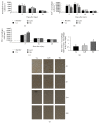Shrimp Protein Hydrolysate Modulates the Timing of Proinflammatory Macrophages in Bupivacaine-Injured Skeletal Muscles in Rats
- PMID: 27868064
- PMCID: PMC5102708
- DOI: 10.1155/2016/5214561
Shrimp Protein Hydrolysate Modulates the Timing of Proinflammatory Macrophages in Bupivacaine-Injured Skeletal Muscles in Rats
Abstract
This study was designed to determine whether marine-derived proteins other than cod could have beneficial effects on inflammation following muscle injury. Macrophage and neutrophil densities were measured from bupivacaine-injured tibialis anterior muscle of rats fed isoenergetic diets containing either shrimp hydrolysate (Shr), casein hydrolysate (CaH), or whole casein (Ca). In this study, Shr reduced ED1+-macrophages at day 2 (p = 0.013), day 5 (p = 0.006), and day 14 after injury (p = 0.038) compared with Ca, indicating faster resolution of inflammation in Shr. Except for day 2 after injury where Shr led to lower ED1+-macrophages compared with CaH (p = 0.006), both Shr and CaH responded similarly at days 5, 14, and 28 after injury. This findings suggest that beneficial effects of Shr on ED1+-cells might be related to generation of anti-inflammatory peptides through the hydrolysis process, in addition to its high content of anti-inflammatory amino acids. However, while increasing myofiber cross-sectional area in noninjured muscles compared with both Ca and CaH, Shr failed to have a positive effect in corresponding injured muscles. These data indicate that shrimp hydrolysate can facilitate resolution of inflammation after muscle injury mainly through modulating proinflammatory macrophage accumulation but have less effect on optimal recovery in terms of muscle mass and fiber size.
Figures






Similar articles
-
Beneficial effects of cod protein on skeletal muscle repair following injury.Appl Physiol Nutr Metab. 2012 Jun;37(3):489-98. doi: 10.1139/h2012-021. Epub 2012 Apr 17. Appl Physiol Nutr Metab. 2012. PMID: 22509810
-
Beneficial effects of cod protein on inflammatory cell accumulation in rat skeletal muscle after injury are driven by its high levels of arginine, glycine, taurine and lysine.PLoS One. 2013 Oct 4;8(10):e77274. doi: 10.1371/journal.pone.0077274. eCollection 2013. PLoS One. 2013. PMID: 24124612 Free PMC article.
-
Beta2-adrenoceptor agonist fenoterol enhances functional repair of regenerating rat skeletal muscle after injury.J Appl Physiol (1985). 2004 Apr;96(4):1385-92. doi: 10.1152/japplphysiol.01081.2003. Epub 2003 Nov 7. J Appl Physiol (1985). 2004. PMID: 14607853
-
Influence of casein and casein hydrolysate diets on nutritional recovery of starved rats.JPEN J Parenter Enteral Nutr. 1995 May-Jun;19(3):216-21. doi: 10.1177/0148607195019003216. JPEN J Parenter Enteral Nutr. 1995. PMID: 8551650
-
Anti-inflammatory interventions and skeletal muscle injury: benefit or detriment?J Appl Physiol (1985). 2013 Sep;115(6):920-8. doi: 10.1152/japplphysiol.00036.2013. Epub 2013 Mar 28. J Appl Physiol (1985). 2013. PMID: 23539314 Review.
Cited by
-
Shrimp Waste Upcycling: Unveiling the Potential of Polysaccharides, Proteins, Carotenoids, and Fatty Acids with Emphasis on Extraction Techniques and Bioactive Properties.Mar Drugs. 2024 Mar 28;22(4):153. doi: 10.3390/md22040153. Mar Drugs. 2024. PMID: 38667770 Free PMC article. Review.
-
Macrophages Are Key Regulators of Stem Cells during Skeletal Muscle Regeneration and Diseases.Stem Cells Int. 2019 Jul 14;2019:4761427. doi: 10.1155/2019/4761427. eCollection 2019. Stem Cells Int. 2019. PMID: 31396285 Free PMC article. Review.
References
-
- Lapointe B. M., Frenette J., Côté C. H. Lengthening contraction-induced inflammation is linked to secondary damage but devoid of neutrophil invasion. Journal of Applied Physiology. 2002;92(5):1995–2004. - PubMed
-
- Dort J., Leblanc N., Maltais-Giguère J., Liaset B., Côté C. H., Jacques H. Beneficial effects of cod protein on inflammatory cell accumulation in rat skeletal muscle after injury are driven by its high levels of arginine, glycine, taurine and lysine. PLoS ONE. 2013;8(10, article e77274) doi: 10.1371/journal.pone.0077274. - DOI - PMC - PubMed
-
- Tidball J. G. Mechanisms of muscle injury, repair, and regeneration. American Journal of Physiology. Regulatory, Integrative and Comparative Physiology. 2029;1(4):2029–2062. - PubMed
MeSH terms
Substances
LinkOut - more resources
Full Text Sources
Other Literature Sources
Medical

